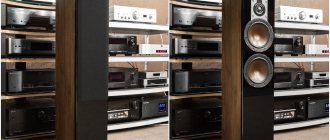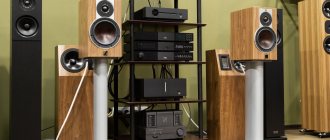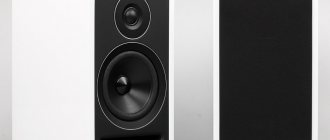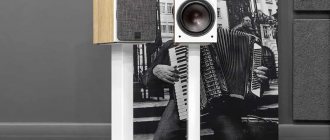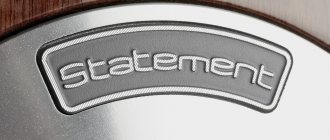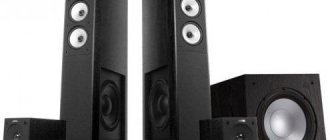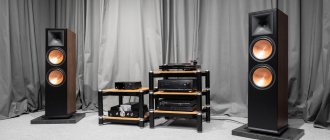The new Dali Oberon 3 speaker system is the senior “bookshelf” model in the Danish manufacturer’s line, which is designed to replace the best-selling Zensor of the past decade. But those who think that this is a simple “cosmetic” design update and an easy improvement in the filling of the bookshelf speaker will be in for a surprise upon closer acquaintance. Of course it's pleasant. And we are ready to lift the veil of secrecy over what awaits you during your first date with this acoustic model. Simply because we understand that the anticipation of the holiday carries half the pleasure of its arrival...
Completely different
The first thing that distinguishes the Oberon series from absolutely all previously released DALI speakers is, of course, the design, or rather, fashionable grills with rounded corners, covered with rough fabric in a vintage style. We have not yet been shown such DALIs. And what a bleached oak colored building with a white facade looks like - a sight for sore eyes! The only pity is that the grills are attached in the old fashioned way and leave behind four round black holes on the front panel, to which the eye inevitably catches. If it weren’t for this annoying fact, it would have turned out absolutely luxurious, but otherwise it’s just very good. A bonus to all this beauty is the competent selection of finishing materials, which, despite their simplicity, do not create a feeling of cheapness, as well as almost impeccable workmanship with precise fitting of parts and the famous branded DALI screws, ideally seated in the holes of the speaker flanges.
Oberon 3 looks especially interesting in light colors
However, not only the appearance, but also the design of Oberon has little in common with the retired Censors. The new product was literally developed from scratch. However, it cannot be said that these speakers were created from scratch. The historical roots of the Oberon series can be traced, but you need to look not at the bottom, but at the top of the line. After all, it is from there that the most advanced technologies get into the junior series. From their older brothers - Rubicon and Opticon - the new Oberon received two important technological solutions at once: the magnetic system of SMC midrange/woofers and an enlarged tweeter with an ultra-light fabric dome.
The inside of the speaker looks no less solid than the outside
Who would have thought that screws could be the subject of serious development?
As a result, Oberon is the most affordable model in the line, featuring a proprietary magnetic system, which most recently was the exclusive privilege of older series. The design of SMC speakers, as well as other proprietary DALI technologies, has been discussed more than once; I will not repeat myself and will remind you of the main features.
The use of soft magnetic material (SMC) in the design of midrange/bass drivers minimizes audible distortion. In practice, this is expressed primarily in a more transparent, clean and detailed sound of mid frequencies. The midrange/bass driver diffuser in Oberon models is made of a paper composite that combines cellulose fibers of different sizes: small fillers and large reinforcing ones. This approach has not changed for a long time, but the diffusers of the budget series had a slightly different appearance, a simpler texture and, apparently, lower density. The diffusers used in the Oberon series, both visually and in terms of density, are more reminiscent of older models.
Large 29mm dome fits well with large woofer
7-inch caliber is no joke! It barely fits on the façade
The large 29mm fabric dome is a means of expanding the effective operating range of the tweeter, allowing it to work more confidently at the interface with the mid/bass driver and making this interface seamless and imperceptible to the ear. And here it is worth paying attention to one more detail concerning the Oberon 3 model specifically. Being quite large bookshelf speakers, they are equipped with large midrange/bass diffusers of a non-standard caliber of 7 inches (178 mm). And a 29 mm tweeter in this case is the optimal solution.
12.02.2019
DALI Oberon 3 acoustics test: another step forward. Stereo & Video, February 2022.
The new line of Oberon acoustics from the Danish company DALI appeared exactly at the moment when the very successful and affordable Zensor series left the scene.
This automatically determined Oberon to be the replacement for the people's favorite Censors. However, the more closely you look at the new product, the more doubts arise that a comparison with Zensor may be appropriate. Personally, I was convinced of this when I got to the older Oberon 3 bookshelf speakers. Completely different The first way the Oberon series differs from absolutely all previously released DALI speakers is, of course, the design, or rather, fashionable grills with rounded corners, covered with rough fabric in a vintage style. style. We have not yet been shown such DALIs. And what a bleached oak colored building with a white facade looks like - a sight for sore eyes! The only pity is that the grills are attached in the old fashioned way and leave behind four round black holes on the front panel, to which the eye inevitably catches. If it weren’t for this annoying fact, it would have turned out absolutely luxurious, but otherwise it’s just very good. A bonus to all this beauty is the competent selection of finishing materials, which, despite their simplicity, do not create a feeling of cheapness, as well as almost impeccable workmanship with precise fitting of parts and the famous branded DALI screws, ideally seated in the holes of the speaker flanges.
Oberon 3 looks especially interesting in light colors
However, not only the appearance, but also the design of Oberon has little in common with the retired Censors. The new product was literally developed from scratch. However, it cannot be said that these speakers were created from scratch. The historical roots of the Oberon series can be traced, but you need to look not at the bottom, but at the top of the line. After all, it is from there that the most advanced technologies get into the junior series. From their older brothers - Rubicon and Opticon - the new Oberon received two important technological solutions at once: the magnetic system of SMC midrange/woofers and an enlarged tweeter with an ultra-light fabric dome.
The inside of the speaker looks no less solid than the outside
Who would have thought that screws could be the subject of serious development?
As a result, Oberon is the most affordable model in the line, featuring a proprietary magnetic system, which most recently was the exclusive privilege of older series. The design of SMC speakers, as well as other proprietary DALI technologies, has been discussed more than once; I will not repeat myself and will remind you of the main features.
The use of soft magnetic material (SMC) in the design of midrange/bass drivers minimizes audible distortion. In practice, this is expressed primarily in a more transparent, clean and detailed sound of mid frequencies. The midrange/bass driver diffuser in Oberon models is made of a paper composite that combines cellulose fibers of different sizes: small fillers and large reinforcing ones. This approach has not changed for a long time, but the diffusers of the budget series had a slightly different appearance, a simpler texture and, apparently, lower density. The diffusers used in the Oberon series, both visually and in terms of density, are more reminiscent of older models.
Large 29mm dome fits well with large woofer
7-inch caliber is no joke! It barely fits on the façade
The large 29mm fabric dome is a means of expanding the effective operating range of the tweeter, allowing it to work more confidently at the interface with the mid/bass driver and making this interface seamless and imperceptible to the ear. And here it is worth paying attention to one more detail concerning the Oberon 3 model specifically. Being quite large bookshelf speakers, they are equipped with large midrange/bass diffusers of a non-standard caliber of 7 inches (178 mm). And a 29 mm tweeter in this case is the optimal solution. Expectations and reality
The internal volume of more than 20 liters and the solid size of the midrange/bass speaker in a bass reflex design give one the right to expect quite solid sound from the Oberon 3. And this is already interesting. However, there is also cause for concern. For their overall dimensions, the weight of the speakers is more than modest. This is because the developers decided to ensure the acoustic inertness of the body not by increasing mass, but by combining high-density MDF, stiffeners and vibration-damping mats. The theory is clear, but did it work in practice?
The reverse side is not so magnificent, but if you wish, you can see in this not a cheapening of the design, but a vintage style
From the first notes, Oberon 3 showed a good claim to success. They met expectations in terms of the low-frequency range, delivering decent bass depth and a fairly sound picture, like small floor-standing speakers. At the same time, the worst expectations were not met - there are no box overtones even at high volumes. The bass reflex, pumping liters of air mass, also showed itself on the positive side already at medium volume. It did not produce any audible artifacts and generally attracted minimal attention to itself.
Vinyl film very convincingly imitates the texture of wood
If we talk about sound in general, Oberon 3 is a worthy keeper of the DALI family traditions. This model successfully combines detail, good tonal balance and timbral richness with a comfortable and expressive presentation of musical material. The stage is built wide and large-scale, with good elaboration of space. At the same time, the speakers are unpretentious in rotating the radiation axis in the horizontal plane; they do not have to be directed at the listening point; parallel orientation of the radiation axes gives perhaps the best result. Oberon 3 is a little more capricious in terms of installation height. For the best focus of the stereo image and the most accurate transmission of the sizes and proportions of sound images, you need to try to equalize the height of the ears and tweeters.
Neat rubber sticker feet included
The expressive sound of midrange frequencies with natural reproduction of the timbres of voices and live instruments goes well with shelf-fast and clear, but floor-deep bass. All this encourages long and thoughtful listening to jazz, rock and blues. Oberon 3 copes equally well with the stolid passages of Norah Jones and the furious pressure of Rage. Modern pop music represented by Dua Lipa and LP was also very good - rhythmic, bright, textured.
Yes, yes, these are branded DALI racks
Given a decent source and amplifier, these speakers seem versatile and self-sufficient. You might want something more on some electronic dance music tracks. This is that rare moment when the thought arises of the need to connect a subwoofer. Imperfections in terms of detail and completeness of timbre reproduction can only be revealed in complex Hi-Res quality recordings. But the pricing policy does not allow us to make any claims in this regard. Oberon 3 earns its money with a good margin. And most importantly, these speakers deliver audiophile and music lover pleasures in equal parts. conclusions
After listening to the DALI Oberon 3 for a while, I found one compelling reason why mentioning any model in this series in the context of Zensor care is absolutely justified. The new Oberons are not just different in design, design and sound quality, they are superior to the Zensor in all respects and can be seen as a logical step towards improving the system. This will, of course, not be a huge leap, but simply the next step forward. Confident and guaranteed to be successful.
Oberon 3 is an example of a competent approach to creating bookshelf acoustics
And in this whole story, I was especially surprised by the pinpoint precision with which DALI developers deliver quality to users. Oberon 3 is definitely good for the money, but it cannot be said that the manufacturer has greatly reduced the price and is selling speakers for a low price that should cost many times more. Do you want heavier cabinets, without grill holes on the snow-white façade, and sound with even higher resolution? Follow all this to the big leagues, and here we have gathered extremely practical people who know how to count money and appreciate design and sound quality.
Advantages:
balanced and musical sound, effective work in the bass range, modern design, good choice of colors, price/quality ratio
Flaws:
grill mounts spoil the appearance of the facade
Passport details
Acoustic design: bass reflex Frequency range: 47-26000 Hz (+/- 3 dB) HF speaker: 29 mm, fabric dome midrange/woofer: 178 mm, paper cone reinforced with wood fiber Crossover frequency: 2400 Hz Sensitivity: 87 dB Impedance: 6 Ohm Recommended amplifier power: 25-150 W Dimensions: 350x200x315 mm Weight: 6.3 kg
Based on materials from Stereo.ru
DALI Oberon in our catalog
DALI brand products in our catalog
#InSound #we know everything about NaimAudio #we know everything about TotemAcousctic #we know everything about TelluriumQ #we know everything about AtlasCables #hifi #music #musiclovers #hifisound #audiosystem #stereo #instahifi #audio #highendaudio #stereosound #hifiaudio
Expectations and reality
The internal volume of more than 20 liters and the solid size of the midrange/bass speaker in a bass reflex design give one the right to expect quite solid sound from the Oberon 3. And this is already interesting. However, there is also cause for concern. For their overall dimensions, the weight of the speakers is more than modest. This is because the developers decided to ensure the acoustic inertness of the body not by increasing mass, but by combining high-density MDF, stiffeners and vibration-damping mats. The theory is clear, but did it work in practice?
The reverse side is not so magnificent, but if you wish, you can see in this not a cheapening of the design, but a vintage style
From the first notes, Oberon 3 showed a good claim to success. They met expectations in terms of the low-frequency range, delivering decent bass depth and a fairly sound picture, like small floor-standing speakers. At the same time, the worst expectations were not met - there are no box overtones even at high volumes. The bass reflex, pumping liters of air mass, also showed itself on the positive side already at medium volume. It did not produce any audible artifacts and generally attracted minimal attention to itself.
Vinyl film very convincingly imitates the texture of wood
If we talk about sound in general, Oberon 3 is a worthy keeper of the DALI family traditions. This model successfully combines detail, good tonal balance and timbral richness with a comfortable and expressive presentation of musical material. The stage is built wide and large-scale, with good elaboration of space. At the same time, the speakers are unpretentious in rotating the radiation axis in the horizontal plane; they do not have to be directed at the listening point; parallel orientation of the radiation axes gives perhaps the best result. Oberon 3 is a little more capricious in terms of installation height. For the best focus of the stereo image and the most accurate transmission of the sizes and proportions of sound images, you need to try to equalize the height of the ears and tweeters.
Neat rubber sticker feet included
The expressive sound of midrange frequencies with natural reproduction of the timbres of voices and live instruments goes well with shelf-fast and clear, but floor-deep bass. All this encourages long and thoughtful listening to jazz, rock and blues. Oberon 3 copes equally well with the stolid passages of Norah Jones and the furious pressure of Rage. Modern pop music represented by Dua Lipa and LP was also very good - rhythmic, bright, textured.
Yes, yes, these are branded DALI racks
Given a decent source and amplifier, these speakers seem versatile and self-sufficient. You might want something more on some electronic dance music tracks. This is that rare moment when the thought arises of the need to connect a subwoofer. Imperfections in terms of detail and completeness of timbre reproduction can only be revealed in complex Hi-Res quality recordings. But the pricing policy does not allow us to make any claims in this regard. Oberon 3 earns its money with a good margin. And most importantly, these speakers deliver audiophile and music lover pleasures in equal parts.
conclusions
After listening to the DALI Oberon 3 for a while, I found one compelling reason why mentioning any model in this series in the context of Zensor care is absolutely justified. The new Oberons are not just different in design, design and sound quality, they are superior to the Zensor in all respects and can be seen as a logical step towards improving the system. This will, of course, not be a huge leap, but simply the next step forward. Confident and guaranteed to be successful.
Oberon 3 is an example of a competent approach to creating bookshelf acoustics
And in this whole story, I was especially surprised by the pinpoint precision with which DALI developers deliver quality to users. Oberon 3 is definitely good for the money, but it cannot be said that the manufacturer has greatly reduced the price and is selling speakers for a low price that should cost many times more. Do you want heavier cabinets, without grill holes on the snow-white façade, and sound with even higher resolution? Follow all this to the big leagues, and here we have gathered extremely practical people who know how to count money and appreciate design and sound quality.
Advantages:
balanced and musical sound, effective work in the bass range, modern design, good choice of colors, price/quality combination.
Flaws:
grill mounts spoil the appearance of the façade.
